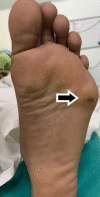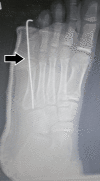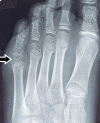A Rare Case of Neglected Fifth Metatarsophalangeal Joint Dislocation
- PMID: 36196311
- PMCID: PMC9524718
- DOI: 10.7759/cureus.28636
A Rare Case of Neglected Fifth Metatarsophalangeal Joint Dislocation
Abstract
The dislocation of the metatarsophalangeal joint of lesser toes is a rare entity. There is a dearth of literature on the same. Also, there is no case described for neglected fifth metatarsophalangeal dislocation in the literature. We present a case of neglected lesser toe dislocation, its natural course, and its outcome after surgical management. Our patient is an eight-year-old child with a neglected dislocation of the fifth metatarsophalangeal joint two years back. The patient did not seek treatment because he has no problem walking. Gradually, there is an abnormal growth of the metatarsal which causes pressure soreness and difficulty walking. The patient was managed surgically with open reduction and K-wire fixation with good long-term results. The dislocation of fifth metatarsophalangeal dislocation is rare and may not cause difficulty in walking due to less weight-bearing. But prompt treatment is necessary, especially in children as the bones have remaining growth potential and may lead to abnormal bone growth.
Keywords: dislocation; foot; lesser toe; metatarsophalangeal joint; neglected.
Copyright © 2022, Sharma et al.
Conflict of interest statement
The authors have declared that no competing interests exist.
Figures





Similar articles
-
Neglected Metatarsophalangeal Joint Dislocation of the Lesser Toe with Associated Metatarsal Fracture Malunion in a 4-Year-Old Child: A Case Report.JBJS Case Connect. 2023 Jan 12;13(1). doi: 10.2106/JBJS.CC.22.00220. eCollection 2023 Jan 1. JBJS Case Connect. 2023. PMID: 36821401
-
Open Reduction of 2nd Metatarsophalangeal Joint as a Method to Reduce Combined Lesser Metatarsophalangeal Dislocation - A Case Report.J Orthop Case Rep. 2024 Apr;14(4):110-114. doi: 10.13107/jocr.2024.v14.i04.4378. J Orthop Case Rep. 2024. PMID: 38681918 Free PMC article.
-
Traumatic irreducible dislocation of the fifth metatarsophalangeal joint in pediatrics: case report and clinical experience.Front Pediatr. 2024 Jan 19;12:1242082. doi: 10.3389/fped.2024.1242082. eCollection 2024. Front Pediatr. 2024. PMID: 38312921 Free PMC article.
-
Rare Lateral Dislocation of the First Metatarsophalangeal Joint: A Case Report and Review of the Literature.J Foot Ankle Surg. 2017 Mar-Apr;56(2):375-378. doi: 10.1053/j.jfas.2016.11.006. Epub 2017 Jan 7. J Foot Ankle Surg. 2017. PMID: 28073653 Review.
-
Another Classification of First Metatarsophalangeal Joint Dislocation-Type 3: Review and Case Description of the Plantar Dislocation.J Foot Ankle Surg. 2019 May;58(3):534-539. doi: 10.1053/j.jfas.2018.09.012. Epub 2019 Mar 20. J Foot Ankle Surg. 2019. PMID: 30902493 Review.
References
-
- Irreducible dislocation of the fifth metatarsophalangeal joint: a case report. Hynes D, D'Souza LG, Stephens M. Foot Ankle Int. 1994;15:625–626. - PubMed
-
- Plantar dislocation of the metatarsophalangeal joint: case report. Stephenson KA, Beck TL, Richardson EG. Foot Ankle Int. 1994;15:446–449. - PubMed
-
- Irreducible dislocation of the fourth metatarsophalangeal joint--a case report. Hey HW, Chang G, Hong CC, Kuan WS. Am J Emerg Med. 2013;31:1–3. - PubMed
-
- Irreducible dorsal metatarsophalangeal joint dislocation of the fifth toe: a case report. Boussouga M, Boukhriss J, Jaafar A, Lazrak KH. J Foot Ankle Surg. 2010;49:17–20. - PubMed
-
- Force, pressure, and motion measurements in the foot: current concepts. Roy KJ. https://europepmc.org/article/med/3293751. Clin Podiatr Med Surg. 1988;5:491–508. - PubMed
Publication types
LinkOut - more resources
Full Text Sources
